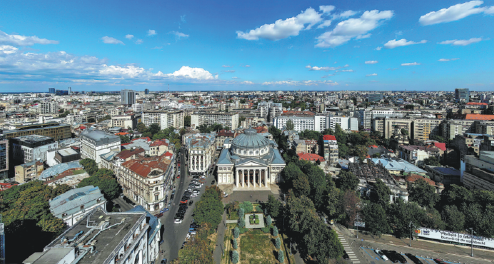China-Romania ties can seek win-win results

Bilateral relationship benefits great nations through trade and cooperative efforts
China and Romania have marked a new chapter in their long-standing relationship by deepening cooperation across key sectors including trade, infrastructure and wider exchanges.
Chinese Ambassador to Romania Han Chunlin recently published an article on People's Daily, emphasizing the deep-rooted history of cooperation between China and Romania.
He noted that over the 75 years of diplomatic relations, both nations have adhered to the principles of mutual respect, equality and win-win cooperation, bringing tangible benefits to their peoples.
In recent years, with the advancement of frameworks such as the Belt and Road Initiative and the China and Central and Eastern European Countries — or China-CEEC Cooperation — economic and trade collaboration between China and Romania has shown strong momentum, Han said.
The two countries have built a robust trade partnership, with China being Romania's largest non-European Union trading partner and bilateral trade surpassing $10 billion annually for three consecutive years.
Chinese customs statistics show that bilateral trade reached a new high of $10.56 billion in 2023. In the first eight months of this year, the China-Romania trade amounted to $8.98 billion, an increase of 26.4 percent year-on-year, outpacing China's trade growth with the EU by 27.4 percentage points.
Of this, China's exports to Romania totaled $6.28 billion, a 20.5 percent rise, and imports from Romania reached $2.69 billion, a 24.4 percent increase. The bilateral trade growth rate exceeded 20 percent from June to August.
In July, China and Romania signed protocols on dairy and wild aquatic product exports, further assisting the entry of Romanian agricultural products into the Chinese market, a new step in deepening bilateral trade cooperation.
Han also mentioned earlier that the fields of cooperation between the two countries are constantly expanding, with more Chinese companies participating in Romania's infrastructure construction, renewable energy and commercial service sectors, contributing to the country's development and transformation. Currently, nearly 14,000 Chinese companies are registered in Romania, with a combined registered capital of $410 million.
Over the long term, Chinese companies have fulfilled their social responsibilities, creating more jobs and helping Romania's economic and social development, he said.
For example, Huawei has been rooted in Romania for 20 years, making significant contributions to the development of Romania's information and communication technology sector. The company currently employs more than 1,300 local staff members and indirectly created more than 6,000 jobs; and another two Chinese auto parts companies, Ningbo Joyson Electronic Corp and NBHX, set up factories in Brasov, Romania, creating more than 4,000 jobs locally.
This year, Chinese companies such as Shanghai Electric, Chint Group and Pinggao Group began construction on renewable energy projects in Romania, promoting the deep and practical development of China-Romania economic and trade cooperation.
Flagship fulfillments
In December 2021, Haier's refrigerator factory in Romania, located in an industrial park about 60 kilometers north of the capital Bucharest, began operations. As Haier's first connected refrigerator factory in the EU, it develops and produces smart and eco-friendly refrigerators under Haier, along with its subsidiary Candy and Hoover brands.
In recent years, Haier's market share in Europe has steadily increased. Building factories in EU countries allows Haier to achieve local design, manufacturing and marketing, better meeting the growing demands of consumers while making product sales and services more convenient, said Sun Shubao, then general manager of Haier Europe.
He emphasized that Romania has comparative advantages in terms of geographic location, human resources and supply chains. The industrial park is close to the capital, surrounded by skilled workers, with convenient transportation, "which shortens logistics and product launch times".
The factory, which began construction in July 2020 with an investment of more than 70 million euros ($76.57 million), has more than 30 advanced robots and other equipment. Its annual design capacity exceeds 1 million units.
Another key cooperation project is China Civil Engineering Construction Corp's ongoing third section of the northern line of the Bucharest Ring Road. It is the first highway project of a Chinese company in Romania.
Sorin Grindeanu, minister of transport and infrastructure of Romania, witnessed the signing of the contract between the CCECC and Romania's National Road Infrastructure Administration Company in March 2023.
He stated that the third section of the project is of great significance to the economic and social development of Romania's capital, and he hoped for its rapid and efficient completion, looking forward to the successful opening of the road.
The Bucharest Ring Road is 100.8 km long and the third section spans 8.6 km with a designed speed of 120-140 km per hour. It has four lanes in both directions and includes seven bridges of various sizes, built to EU standards. The contract period is 30 months, with 12 months for design and 18 months for construction.
Broader exchanges
Since the 1950s, when the first group of Romanian students traveled to China, the cultural and educational ties between China and Romania have significantly deepened. This year marked the unveiling of Romania's fifth Confucius Institute, which highlights the exchanges in culture, education, tourism and science over the decades, alongside milestones such as the introduction of the first Romanian film, Life Triumphs, in 1953, and the "China Season" at the Sibiu International Theatre Festival for six consecutive years.
Launched in April, Romania's fifth Confucius Institute is a collaborative effort between the "Grigore T. Popa" University of Medicine and Pharmacy of Iasi, or UMF Iasi, and Huazhong University of Science and Technology, or HUST. Notably, it is the country's first Confucius Institute specializing in traditional Chinese medicine.
Viorel Scripcariu, the rector of UMF Iasi, emphasized the profound significance of the institute's establishment. He expressed hope that this platform would serve as a center for Chinese-Romanian language and cultural exchanges, opening a new chapter in traditional Chinese medicine education and acting as a bridge for cooperation between the two universities.
Ma Jianhui, deputy Party secretary of HUST, underscored the institute's role in strengthening educational and cultural ties between China and Romania. He stated that it would enhance the Romanian people's understanding and appreciation of Chinese culture while integrating medical education to cultivate more interdisciplinary talents.
In the field of science and technology, China and Romania's collaboration has led to the establishment of joint laboratories dedicated to various research areas, including agriculture, environmental science and biotechnology.
wangjinhui@chinadaily.com.cn




















